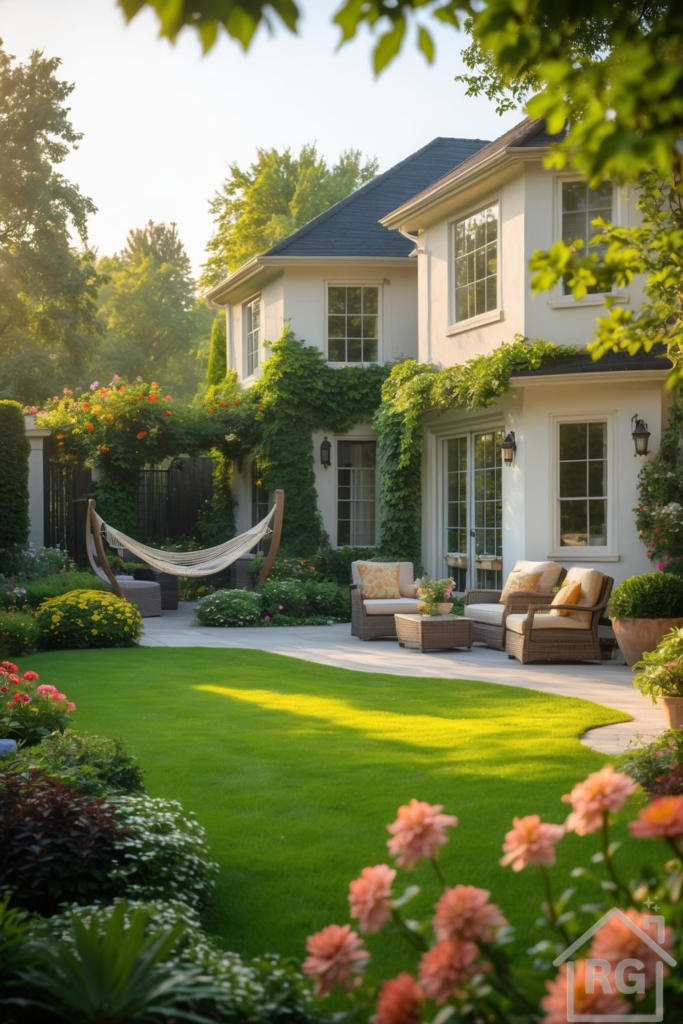
Transforming your outdoor area into a true extension of your home, offering both relaxation and aesthetic pleasure, is the essence of a backyard oasis. Cultivating such a serene and inviting environment requires careful consideration of several key elements: hardscaping, planting, furniture, and subtle decorative touches. This comprehensive guide will walk you through everything you need to create your own dream backyard oasis.
Laying the Foundation: Hardscaping and Spatial Planning
The backbone of any well-designed outdoor space is its hardscaping. A well-planned patio, for instance, can serve as a central hub, seamlessly connecting your home to the garden and setting the stage for your outdoor oasis.
Patio Perfection: Material and Shape
A well-designed patio, often featuring large, light grey pavers with a gentle, curving edge, can soften the transition to your lawn and create an inviting feel. When choosing materials for your patio, consider:
- Natural Stone: Options like bluestone, travertine, or limestone offer timeless elegance and durability. They come in various shades, from cool greys to warm beiges, and can be laid in irregular patterns or precise cuts.
- Concrete Pavers: A versatile and often more budget-friendly choice, concrete pavers are available in a vast array of colors, shapes, and textures, mimicking natural stone or brick. They are highly durable and require minimal maintenance.
- Porcelain Tiles: Increasingly popular for outdoor use, porcelain tiles are non-porous, fade-resistant, and incredibly durable. They can replicate the look of wood, stone, or concrete with precision.
A curved edge can be achieved with careful cutting of pavers or by selecting materials that allow for more fluid designs. This choice helps to break up the rigidity of straight lines, creating a more natural and flowing landscape.
Defining Outdoor Zones
A successful outdoor space often divides into distinct zones, even within a relatively compact area. Consider creating:
- A Lounging Patio: A primary seating area for conversation and relaxation, directly accessible from the house.
- A Verdant Lawn: An open, green space providing visual relief and room for activities.
- A Hammock Nook: A secluded spot for ultimate relaxation, nestled amidst the greenery.
When planning your layout, think about how you want to use each area. Consider sun exposure throughout the day, proximity to the house for convenience, and privacy from neighbors.
Vertical Elements: Walls and Fences
Your home’s facade, perhaps with a cream-colored stucco and a dark roof, can act as a significant vertical element, providing a beautiful backdrop for your garden. Climbing vines can soften its appearance, integrating it into the landscape. A dark metal fence can offer privacy without being visually heavy, allowing lush planting to take center stage. When selecting fences or walls, consider materials like:
- Wood: Offers warmth and natural beauty, and can be stained or painted.
- Metal: Provides a sleek, modern, or classic look depending on the design (e.g., wrought iron, aluminum).
- Masonry: Stone or brick walls offer robust privacy and a classic aesthetic.
Integrating vertical greenery, such as climbing plants on trellises or walls, is an excellent way to enhance privacy and add a layer of natural beauty.
The Green Heart: Landscaping and Planting Design
Vibrant greenery is often the most striking feature of any backyard oasis. A healthy, well-maintained lawn, layered planting, and strategic use of climbing plants all contribute to a lush, inviting atmosphere.
The Verdant Lawn
An immaculate green lawn provides a soft, inviting carpet that contrasts beautifully with hardscaping and vibrant flower beds. Achieving such a lawn requires:
- Proper Grass Selection: Choose a grass type suited to your climate and sun exposure (e.g., Bermuda grass for warm climates, Kentucky bluegrass for cool climates, or fescue for shade tolerance).
- Regular Maintenance: Consistent mowing, watering, fertilization, and aeration are crucial for a dense, healthy turf.
Layered Planting for Depth and Interest
Garden beds designed with varying heights and textures create depth and visual interest. Think about layering your plants:
- Tall Backdrops: Mature trees and tall evergreen shrubs provide a sense of enclosure and privacy. Consider trees like maples, oaks, or evergreens like arborvitae or Leyland cypress for structure and year-round greenery.
- Mid-Level Flowering Shrubs: For bursts of color, consider mid-sized shrubs. Excellent choices include:
- Spiraea: Many varieties offer clusters of white, pink, or yellow flowers and attractive foliage.
- Hydrangeas: Known for their large, showy blooms in various colors, thriving in partial shade.
- Knock Out Roses: Low-maintenance roses that provide continuous blooms in shades of red, pink, and yellow.
- Azaleas/Rhododendrons: Offer spectacular spring blooms in a wide range of colors, ideal for acidic soils.
- Daylilies: Hardy perennials with a vast array of flower colors and forms, blooming over a long period.
- Groundcovers and Perennials: At the front of the beds, lower-growing plants add texture and fill in gaps. Consider:
- Hostas: Perfect for shady spots, offering diverse leaf shapes and colors.
- Ferns: Provide delicate, feathery texture for shaded areas.
- Sedum: Drought-tolerant succulents with interesting foliage and late-season blooms.
- Creeping Thyme: A fragrant, low-growing groundcover that can tolerate some foot traffic.
- Impatiens or Begonias: For continuous color in shadier spots.
- Zinnias or Marigolds: For bright, long-lasting color in sunny areas, similar to vibrant orange and pink flowers.
The Charm of Climbing Plants
Adorn your house facade with lush climbing vines to create a romantic, established look. An archway covered in vibrant orange blooms can add another layer of natural beauty. Consider these options:
- For House Walls:
- Boston Ivy or Virginia Creeper: Self-clinging vines that provide dense green coverage and beautiful fall color.
- Climbing Hydrangea: Offers attractive foliage and white lacecap flowers, clinging with aerial roots.
- For Arbors/Pergolas:
- Wisteria: Known for its dramatic, fragrant purple or white flower clusters.
- Clematis: Offers a wide variety of flower shapes and colors, many with long blooming periods.
- Trumpet Vine (Campsis radicans): A vigorous climber with striking orange or red trumpet-shaped flowers. Be mindful of its vigorous growth.
- Climbing Roses: Provide classic beauty and fragrance.
Ensure you provide proper support structures for climbing plants, such as trellises or wires, to guide their growth and protect your home’s exterior.
Potted Plants: Versatility and Mobile Color
Pots filled with lush greenery and flowers add a touch of classic charm and allow for flexible design. Potted plants are excellent for:
- Adding Instant Color: Easily swap out seasonal flowers.
- Filling Gaps: Place them where garden beds end or on the patio.
- Creating Focal Points: A large, striking plant in a beautiful pot can draw the eye.
- Bringing Plants Indoors: Some tender plants can be moved inside during colder months.
Choose pots that complement your overall design aesthetic – terracotta for a rustic or Mediterranean feel, glazed ceramic for a pop of color, or modern concrete for a minimalist look.
Comfort and Style: Furniture and Decor
The right furniture and decor can transform an outdoor space into a truly livable area, speaking to comfort and inviting relaxation.
The Inviting Seating Area
A wicker patio set, with its plush, light-colored cushions, can be the epitome of outdoor comfort. Wicker furniture is a popular choice for several reasons:
- Durability: Modern outdoor wicker is typically made from synthetic resin, which is weather-resistant, UV-stabilized, and easy to clean, unlike natural wicker which can degrade outdoors.
- Aesthetics: It offers a classic, timeless look that blends well with natural surroundings.
- Comfort: When paired with thick, weather-resistant cushions, it provides exceptional comfort for lounging and conversation.
When arranging your seating, aim for a conversational grouping. Two armchairs and a coffee table can create an intimate setting perfect for morning coffee or evening drinks. Consider adding a small outdoor rug to define the space and add warmth.
The Ultimate Relaxation Nook: A Hammock
A freestanding hammock with a sturdy wooden frame is a clear invitation to unwind. A hammock offers a unique spot for reading, napping, or simply enjoying the breeze.
- Freestanding vs. Hung: A freestanding hammock offers flexibility in placement, as it doesn’t require trees or posts. Wooden frames add a natural, elegant touch.
- Placement: Position your hammock in a spot that offers a good view, some shade during the hottest parts of the day, and a sense of peaceful seclusion.
Nearby, small wicker ottomans or stools can provide additional seating or a place to rest a drink, enhancing the functionality of this relaxation zone.
Outdoor Textiles and Accents
Light-colored cushions and patterned throw pillows on your outdoor furniture add layers of comfort and visual appeal.
- Weather-Resistant Fabrics: Invest in cushions made from outdoor-grade fabrics like Sunbrella or Olefin, which are resistant to fading, mildew, and moisture.
- Pillows and Throws: These are easy ways to introduce color, pattern, and texture. Choose colors that complement your garden’s palette – perhaps soft greens, warm oranges, or muted yellows to echo the flowers.
Ambiance and Details: Lighting and Decor
The subtle details are what elevate an outdoor space from functional to truly magical, creating the perfect ambiance.
Thoughtful Lighting
Outdoor lighting is crucial for extending the usability and enhancing the ambiance of your backyard after dusk. Wall-mounted sconces can provide functional illumination. Consider adding:
- String Lights: Hung over the patio or through trees, they create a festive, whimsical glow.
- Path Lights: To illuminate walkways and highlight garden features safely.
- Uplighting: To showcase trees or architectural elements of your home.
- Solar Lights: An easy, energy-efficient option for subtle accent lighting.
- Candles or Lanterns: For a soft, intimate glow on tables.
Decorative Touches
Small decorative elements tie the space together and add personality:
- Potted Flowers: A small arrangement of fresh flowers on the coffee table adds a touch of living beauty.
- Garden Art: Sculptures, bird baths, or wind chimes can add personality.
- Water Features: A small fountain can introduce soothing sounds and attract wildlife.
DIY Ideas and Maintenance Tips
Creating a backyard oasis doesn’t have to break the bank. Many elements can be achieved with a bit of DIY spirit:
- DIY Planter Boxes: Build custom wooden planter boxes to add raised garden beds or define patio edges.
- Simple Arbor: Construct a basic wooden arbor for climbing plants using readily available lumber.
- Repurpose Furniture: Give old outdoor furniture a new lease on life with a fresh coat of paint and new cushions.
Regular maintenance is key to preserving the beauty of your outdoor space. This includes:
- Watering: Ensure plants receive adequate water, especially during dry spells. Consider irrigation systems for efficiency.
- Pruning and Weeding: Keep plants healthy and beds tidy by regularly pruning and removing weeds.
- Fertilizing: Feed your lawn and plants as needed to promote vigorous growth.
- Furniture Care: Clean outdoor furniture regularly and store cushions during harsh weather to prolong their life.
Conclusion
Creating a backyard oasis is a masterclass in blending natural beauty with comfortable living. By focusing on a well-designed patio, layered and vibrant planting, comfortable and durable furniture, and thoughtful lighting, you can transform your own outdoor space into a personal sanctuary.
Whether you’re dreaming of a lively entertaining area, a quiet reading nook, or a lush garden retreat, these principles will guide you in creating a backyard that truly reflects your vision and enhances your lifestyle. Embrace the journey of cultivating your own slice of outdoor paradise!
